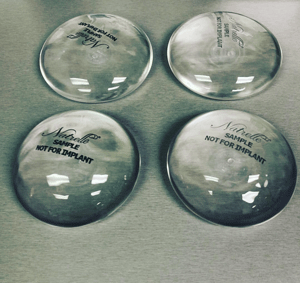Types of breast implant – which is best?
If you’re considering breast augmentation, it’s very important that you understand the different types of breast implant on the market. Breast implants fall into two main categories: Silicone and Saline.
Silicone Breast Implants
Safety of silicone breast implants
Silicone breast implants have been on the market since 1961; they actually pre-date the FDA! But because of concerns about safety, silicone breast implants have been studied more than nearly any other medical device on the market. Silicone implants are composed of a silicone shell filled with silicone gel.
A full discussion of the safety debate would take up an entire book (and many have been written on the topic), so for now I’m just going to say that both types of breast implant are equally safe. And after studying tens of thousands of patients, we know that implants do not increase your risk for connective tissue disease such as lupus or rheumatoid arthritis.
Pros of silicone breast implants:
- Silicone implants give a more natural feel compared to saline.
- They are less likely to show rippling compared to saline.
- Silicone implants come in different degrees of firmness, from soft to quite firm. Even the softer implants on the market today contain very thick gel which is more solid than liquid. So unlike the gel implants of the 1980s, the silicone is less likely to move outside the implant pocket.
Cons of silicone breast implants:
- Silicone gel is so viscous that you can’t always tell if they rupture just by look or feel- an MRI may be necessary.
- Silicone implants come in pre-filled sizes, so the size isn’t completely adjustable.

Saline Breast Implants
Saline breast implants actually came on the market slightly after silicone implants, in 1964. Silicone implants are composed of a silicone shell filled with saltwater solution.
Pros of saline breast implants
- Saline implants are adjustable in size, so it may be easier to correct for breast asymmetry.
- You will know if a saline breast implant ruptures because the saline reabsorbs and the implant deflates.
Cons of saline breast implants.
- Saline doesn’t feel quite as natural as silicone.
- Saline implants may show rippling, especially in thin patients.
Cost vs. breast implant type:
Silicone implants do cost a little bit more than saline implants, on the order of a few hundred dollars.
What about textured implants and anatomic implants?
Let’s wrap up with a quick review of the different types of implant shells. So far we’ve discussed what is inside the implant (silicone or saline). But implant shells come in both smooth and textured. Textured implants were quite popular initially because they have a lower risk of capsular contracture. But over the past few years we’ve discovered a higher association with a very rare type of lymphoma (only 600 cases worldwide associated with implants). For this reason, most surgeons I know have switched over to smooth implants only.
Implants also come in two shapes: round and anatomic (aka tear-drop). The anatomic implants can give a more natural appearance in very thin patients or after reconstruction, but they must be textured so they stay in place without rotating. So again, the use of anatomic implants has dropped way off.
I hope you found the discussion of different types of breast implant helpful. You can always find more on my website, or email me at jg****@do****.com if you have questions.

